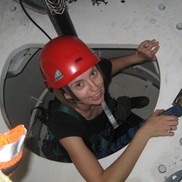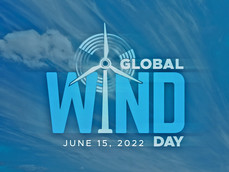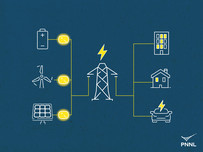Clean Energy Champions

Alice Orell is a mechanical engineer and Manager of the Distributed Wind Program at DOE’s Pacific Northwest National Laboratory. When asked for advice to those entering the wind energy field, Alice stresses the importance of finding the right home because “the wind industry has a job for everyone.” From wind resource assessment analysts all the way to turbine engineers and designers, every role is needed for a future of 100% clean energy!
Read more about Alice and other PNNL wind industry professionals.
|
Research & Development Feature
 The Stochastic Soaring Raptor Simulator (SSRS) developed at the National Renewable Energy Laboratory (NREL) is designed to predict movements of soaring raptors (such as golden eagles) with the goal of determining potential negative interactions between soaring raptors and wind turbines. The model, which is publicly accessible on GitHub, will use a site’s particular details to simulate long-distance movement of golden eagles, including migration.
“A golden eagle’s goal to minimize its energy expenditure will affect its decision making. The model uses that principle to generate a map of probable paths the eagle might take,” said Rimple Sandhu, a postdoctoral researcher at NREL and the lead author on the article published in Ecological Modelling. Read more about the Stochastic Soaring Raptor Simulator.

Projections of the future cost of wind and solar generation can help inform research and development investments and power sector planning. But accurately projecting the future cost of renewable generation is challenging.
A new study from Berkeley Lab published in the journal iScience uses a new methodology to predict patterns for utility-scale wind and solar costs. The study concludes that the cost of wind and solar energy will progressively decline in the coming years.
|
News
Today the U.S. Department of Energy announced it is joining a new partnership to grow a U.S.-based supply chain for the burgeoning offshore wind industry. The Federal-State Offshore Wind Implementation Partnership is a joint effort launched by the White House National Climate Advisor, the Secretaries of the Interior, Energy, Commerce and Transportation, and governors of 11 East Coast states. The partnership highlights ongoing DOE efforts and commitment work alongside states and industry to provide a roadmap that identifies key pathways for meeting state and federal offshore wind goals.

Global Wind Day was on “Winds-day,” June 15. Meet some of the “Wizards of Wind Energy” from DOE’s Pacific Northwest National Laboratory (PNNL) who make the magic happen in several areas, including wind-grid integration, offshore and land-based wind, distributed wind, wind model validation, and wind and wildlife interaction. We introduce you to PNNL’s Wind Wizards Alice Orrell, Bharat Vyakaranam, Daniel Deng, Lindsay Sheridan, Mark Severy, and Nader Samaan. Learn about the research they perform in support of DOE’s Wind Energy Technologies Office, their “magical powers” when it comes to wind energy, some of their favorite wind energy fun facts, and advice for those entering the wind energy field.
|
DOE announced that it will work with 12 competitively selected remote and island communities around the United States to help strengthen their energy resilience through the agency’s Energy Transitions Initiative Partnership Project (ETIPP). Four national laboratories and six regional partner organizations will collaborate with these communities to address their unique energy resilience challenges related to aging energy infrastructure, high energy costs, and rapidly escalating impacts of climate change. Their project proposals explore options for energy efficiency in buildings, renewable energy planning, microgrids, and energy storage.
DOE’s Oak Ridge National Laboratory published a study as part of the MADE3D initiative highlighting additive manufacturing (3D printing) of permanent magnets for large electrical machines. Additive manufacturing could be an attractive method for manufacturing permanent magnets, as it minimizes the use and waste of critical, supply-limited rare earth materials and enables printing of complex shapes. The study explores the benefits and advantages of additive manufacturing over conventional methods in creating permanent magnets. It also looks at the use of additive manufacturing for permanent magnets on wind turbine generators and large electrical machines and how this manufacturing method can address the problems associated with supply chain issues of critical rare earth materials.

PNNL researchers developed a new computer model of a device that acts like a translator, enabling renewable power sources like wind and solar to provide electricity to the grid. This grid-forming inverter enables utility operators to test how to safely add new power sources to the grid that increase system resiliency and stability. A stable grid is imperative because it means reliable power and thus, fewer outages. Recently approved by the Western Electricity Coordinating Council, the model is now available to be integrated into grid simulation tools used by thousands of utilities in North America!
|
Events
Workshop: June 28, 2022, 12 p.m. ET, Virtual
This workshop, hosted by DOE and the U.S. Department of Interior’s Bureau of Ocean Energy Management, will focus on strategies to support sustainable and equitable development of offshore wind transmission that minimizes impacts to ocean co-users and marine environments and creates benefits for coastal and underserved communities, and the Nation as a whole. Registration is required and is requested as soon as possible. Comments can also be submitted to OSWTransmission@hq.doe.gov through August 1, 2022.
Conference: October 18–19, 2022, Providence, RI
The American Clean Power Association is hosting the Offshore WINDPOWER conference, which will feature panels, presentations, workshops, and poster sessions focusing on the future of offshore wind. Stop by the DOE booth to learn about its offshore wind research and newest initiatives.
Workshop: October 17–20, 2022, Albuquerque, NM
The workshop brings together wind industry experts, wind farm stakeholders and operators, manufacturers, and researchers to address the major topics for wind turbine blades, facilitate interaction and networking among the attendees, and identify future technology pathways. For more information, visit Sandia’s website.
In Case You Missed It
|